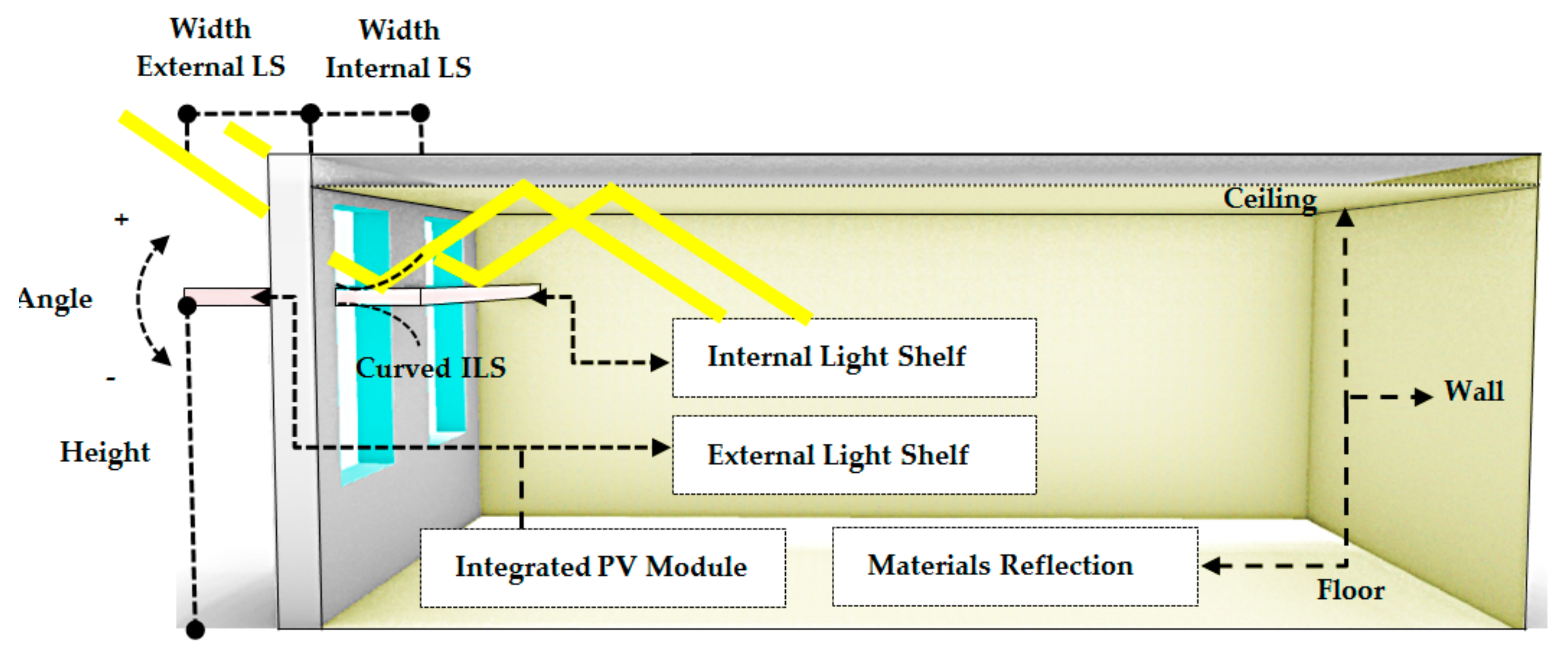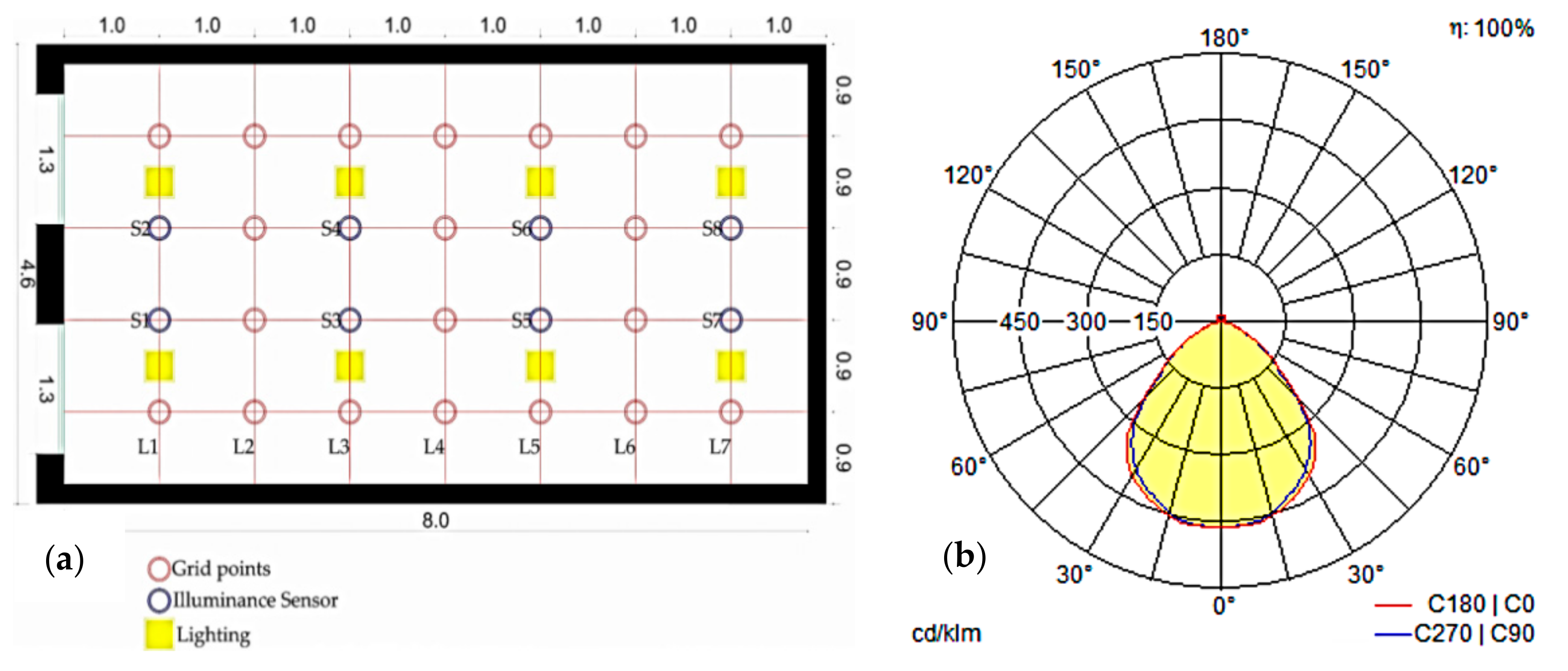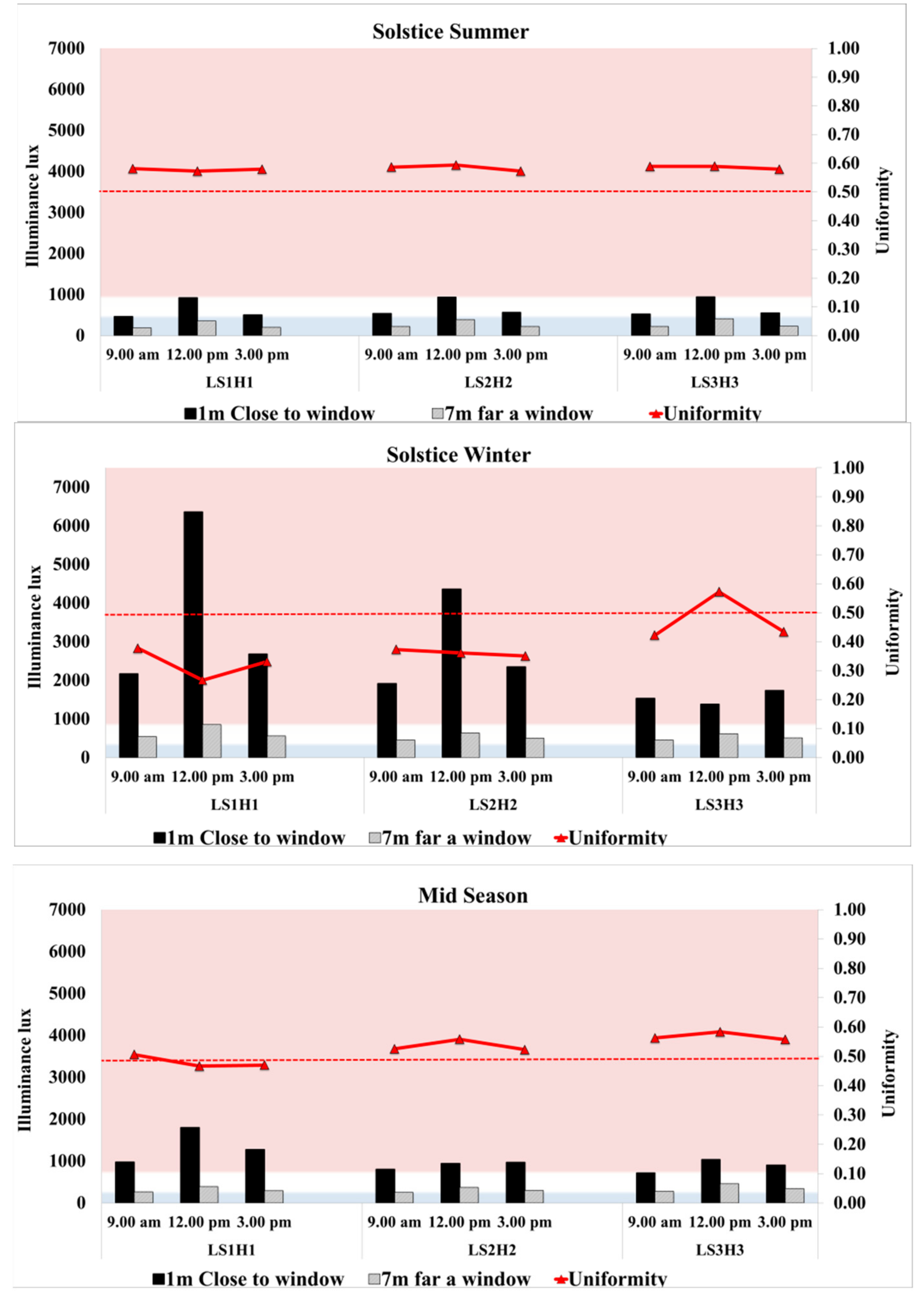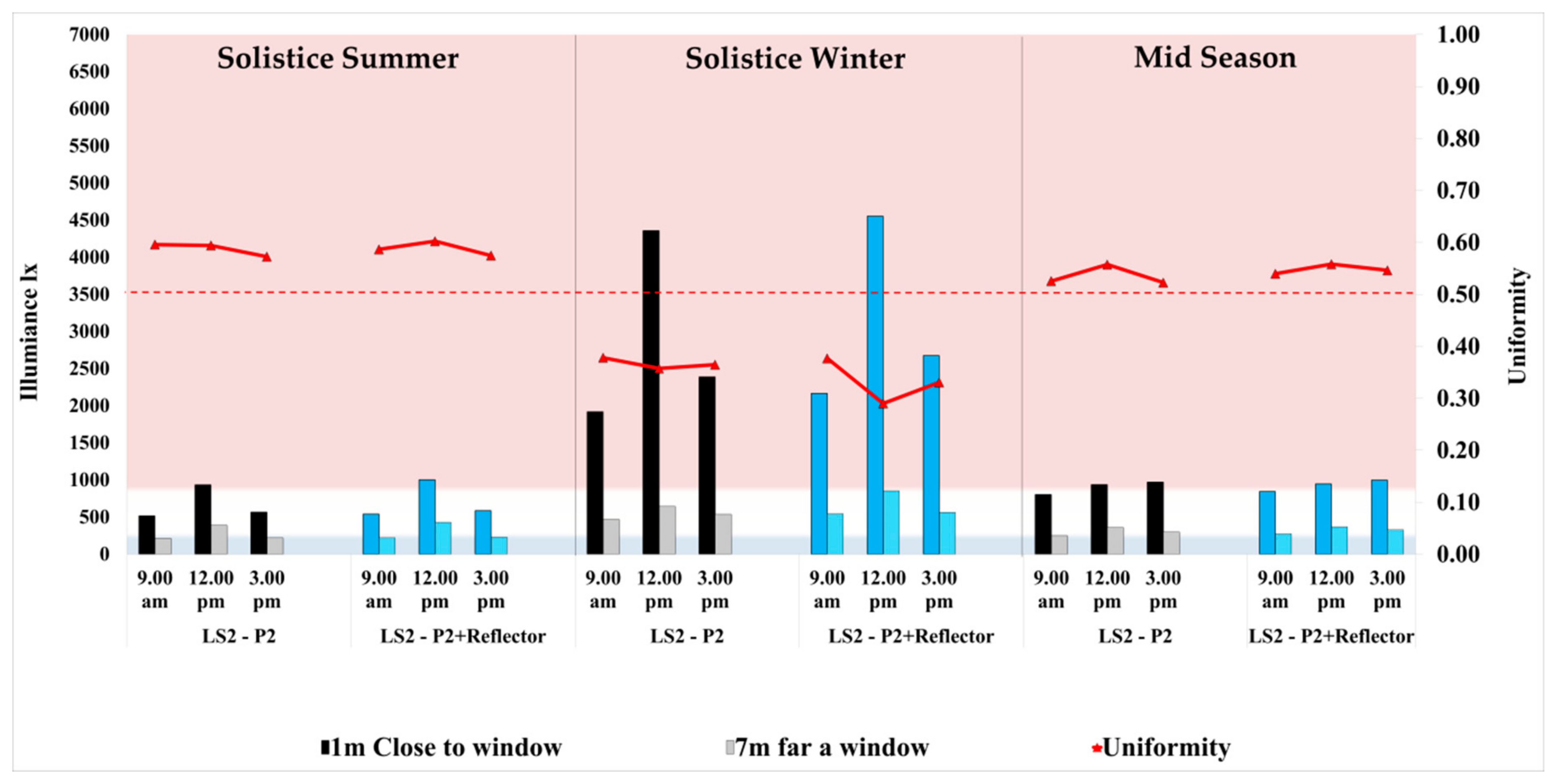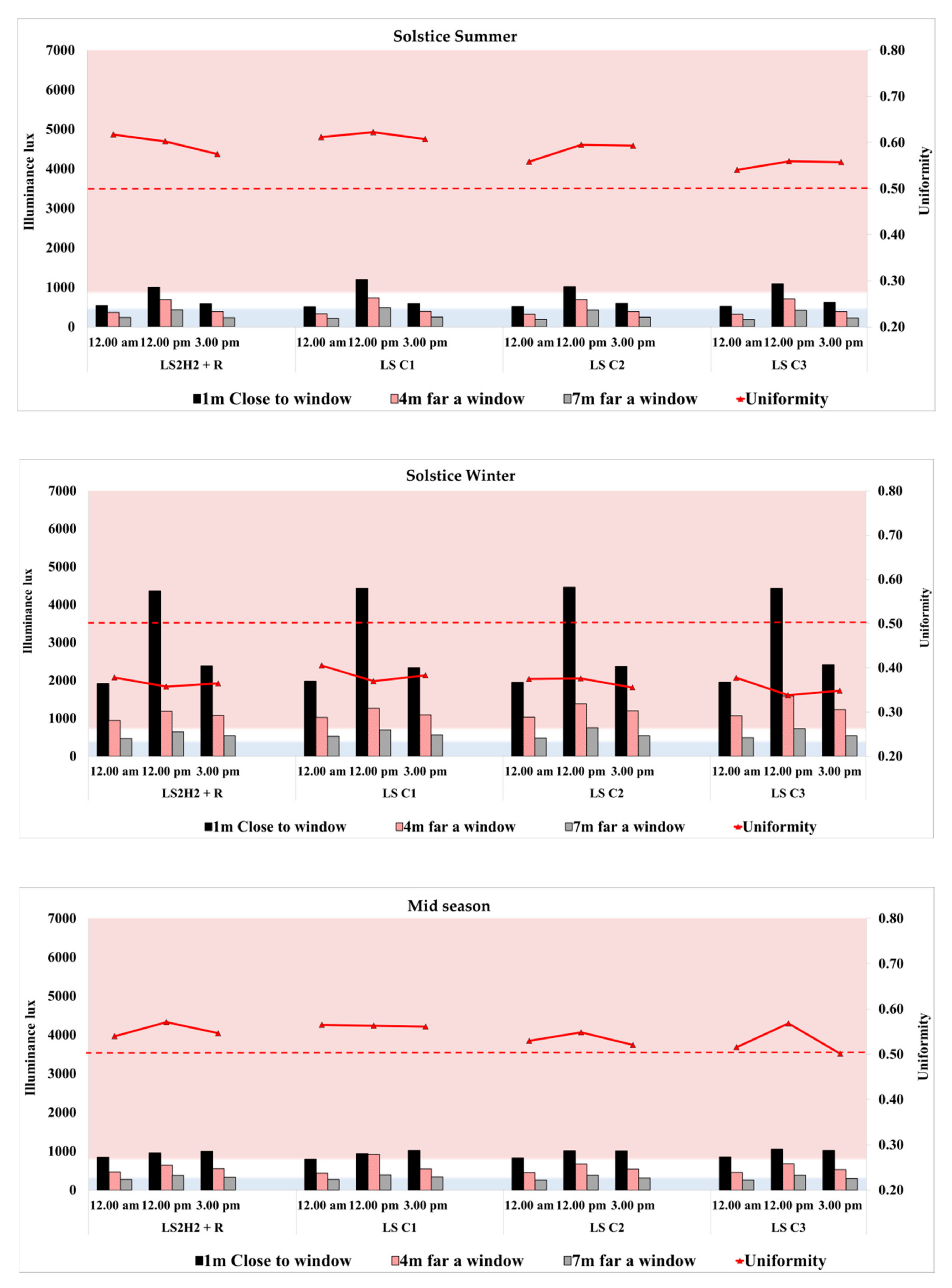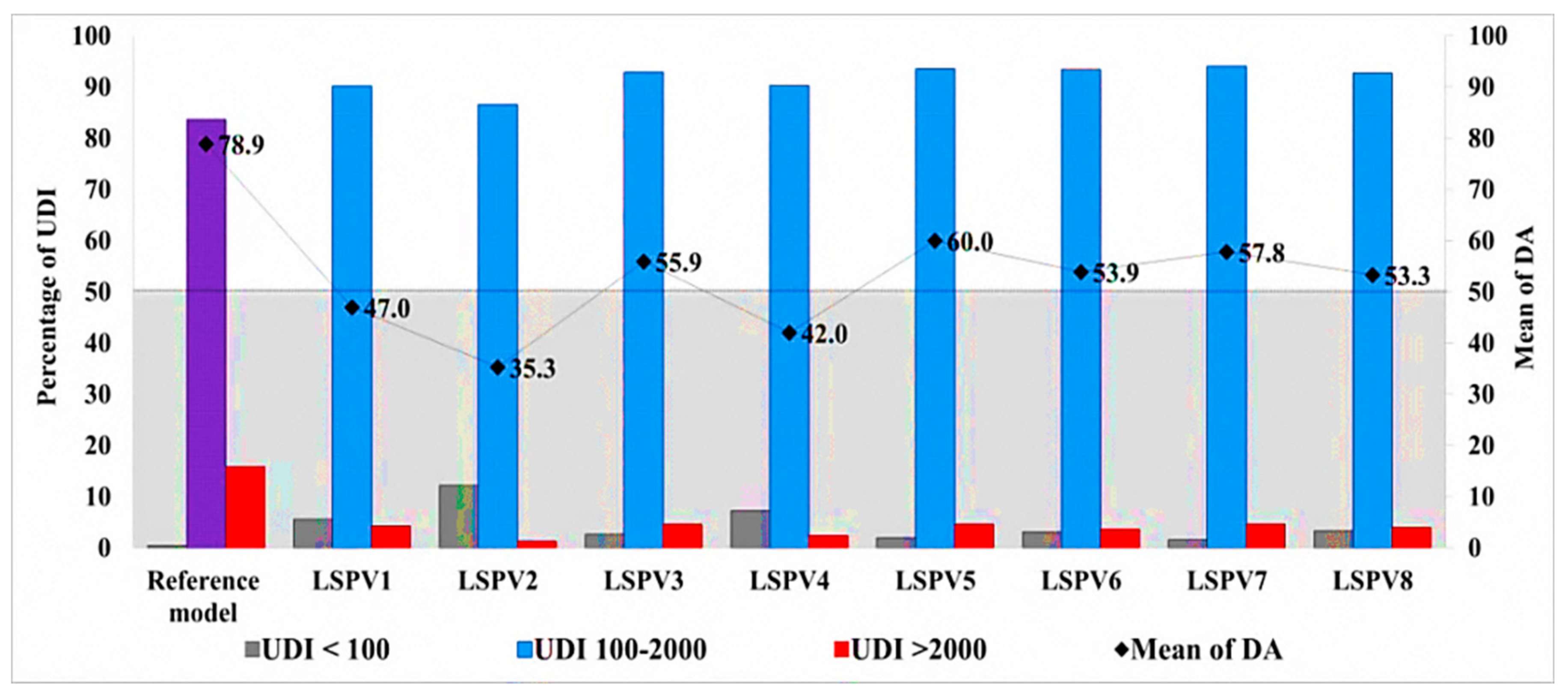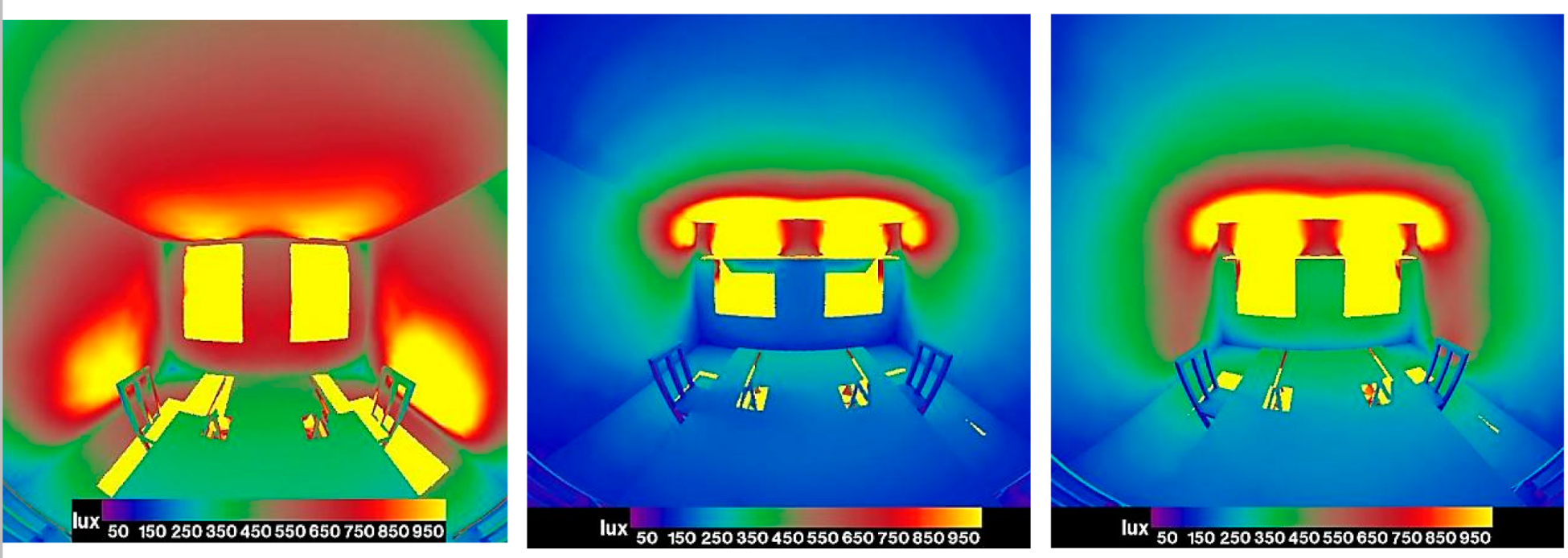1. Introduction
Presently, the Kingdom of Saudi Arabia is witnessing unprecedented development as part of the implementation of its ambitious 2030 vision. Launched in 2016, the vision intends to build a thriving, diversified, and sustainable economic model which has a lesser dependence on the income from oil and savings from fossil fuel subsidies [
1]. Solar energy has been recognized as a relatively significant source of renewable energy compared to the other sustainable energy sources in the Kingdom of Saudi Arabia. Considering the ample solar radiance and the prevailing desert-like climatic conditions [
2], photovoltaic (PV) technology could play a vital role in overcoming energy issues in this hot and arid region [
3]. The Saudi Electricity Company revealed that lighting accounts for over 30% of the total energy consumed in office buildings to provide the required amount of light [
4]. Therefore, the rationalization of energy use and the improvement of daylighting design techniques such as light shelves [
5,
6,
7], semi-transparent photovoltaics (STPV) [
8], louvers [
9], and light transportation [
10] need to be considered.
One of the essential daylighting techniques is light shelves. A light shelf is a horizontal surface that reflects daylight deep inside a building. Light shelves are placed above eye-level and have highly reflective upper surfaces that reflect daylight onto the ceiling and deeper into a space. It is a flexible system that offers a variety of design solutions. It can be installed easily on an external or internal surface [
6], and can be designed in various geometries like fixed flat models and curved reflective surfaces [
11], dynamic shading device design [
5,
12], and integrated as a solar module [
13]. Thus, precise operation of the various design solutions associated with light shelves, such as solar modules, is required to enhance lighting and electricity generation efficiency in response to external conditions, as depicted in
Figure 1.
Much research has been conducted concerning the daylight performance of light shelves using several configurations (dimensions, geometry, angles, and material) using experiments in the field under varying sky conditions or through simulations. As specified in
Table 1, previous research has primarily evaluated the optimization of the aspects concerning light shelves to enhance the distribution of daylight in vast spaces to facilitate enhanced visual comfort. Nevertheless, there was specific research concerning a light shelf whose width and length was modified by isolating the light shelf reflector along with the bottom and top reflectors [
14].
Several other studies analyzed an integration of building envelope technologies like louvres [
15], in-built photovoltaics (PV) [
13], and awning systems [
16] to facilitate a decrease in the energy requirements of the building. A review of the existing literature indicates that there are only a few pieces of research that assess the performance of solar panels integrated with light shelves. Hwang et al. [
17] examined the characteristics of the light shelf system using in-built PVs by lining the outer light shelf with solar panels in a southern orientation, placed at varying angles. Heangwoo Lee [
13] recently suggested a solar-integrated light shelf having only a fraction of it covered with solar panels at varying angles; however, the internal shelf would not be used. Hence, the current study aims to assess the optimum performance of the combination of external and internal light shelves using integrated solar panels in several places to facilitate the appropriate distribution of daylight in the office structure and optimize energy savings, especially under the hot desert-like climatic conditions of Ha’il city.
Table 1.
Studies conducted on light shelf performance on daylighting.
Table 1.
Studies conducted on light shelf performance on daylighting.
| Title of Study and Year | Light Shelf Parameters | Experimental Measurement | Daylighting Simulation | Integrated PV with Light Shelf |
|---|
| Maximizing the light shelf performance by interaction between light shelf geometries and a curved ceiling, Jordan, 2010 [11] | Geometries, curved ceiling | no | yes | no |
| Power performance of photovoltaic-integrated lightshelf systems, South Korea, 2014, [17] | Full solar panel (one size) | yes | yes | yes |
| Analysis of the Impacts of Light Shelves on the Useful Daylight Illuminance in Office Buildings in Toronto, 2015, [18] | Width, depth, and height | no | yes | no |
| Dynamic internal light shelf for tropical daylighting in high-rise office buildings, Malaysia, 2016, [5] | Height of ILS, number of ILS | yes | yes | no |
| Evaluating daylight performance of light shelves combined with external blinds in south-facing classrooms in Athens, 2016, [15] | Material, angle, combination with louvers | no | yes | no |
| Investigating the Influence of Light Shelf Geometry Parameters on Daylight Performance and Visual Comfort, a Case Study of Educational Space in Tehran, Iran, 2016, [19] | Dimension, angle, orientation | no | yes | no |
| Energy-saving performance of light shelves under the application of user-awareness technology and light-dimming control, South Korea, 2018, [20]. | Angle | yes | yes | no |
| A preliminary study on the performance of an awning system with a built-in light shelf, South Korea, 2018, [16]. | Angle, awning system | yes | yes | no |
| Development and Performance Evaluation of Light Shelves Using Width-Adjustable Reflectors, South Korea, 2018, [21]. | Width adjustability | yes | no | no |
| Performance evaluation of a light shelf with a solar module based on the solar module attachment area, South Korea, 2019, [13]. | Angle, PV coverage | yes | yes | yes |
| Experimental Analysis of the Performance of Light Shelves in Different Geometrical Configurations Through the Scale Model Approach, South Korea, 2020, [6]. | Angle, curved LS, ILS reflector | yes | no | no |
| Optimization of Daylight Performance Based on Controllable Light-shelf Parameters using Genetic Algorithms in the Tropical Climate of Malaysia, 2020, [22] | Angle, width/depth ratio, height, and reflectivity | yes | yes | no |
| Performance Evaluation of External Light Shelves by Applying a Prism Sheet, South Korea, 2020, [23]. | Applying prism sheets with angles | yes | no | no |
1.1. The Sun Path of Ha’il City
Sun path diagrams are appropriate for depicting the annual changes happening about the Sun’s path. As shown in
Figure 2, the midday sun in Ha’il city is at a 39° inclination during the winter solstice. The inclination is 84° during the summer solstice. These numbers indicate a 45° deviation between the solstices as a result of the Earth’s declination, varying between −23° and +23° over the year. In contrast, during spring and autumn, the Sun has a similar path and an inclination of 63°, which is present between the two solstices.
The solar energy incident on the southern and northern parts of the building is not the same since the southern side has better incident sunlight compared to the northern side. In contrast, considering the eastern and western directions, the incident solar energy exhibits symmetry. As a result, there should be a difference in the light intensity once the light shelves are attached.
1.2. Recommended Indoor Illuminance
According to the International Organization for Standardization (ISO) standard 8995-1:2002 [
24], typically, the illumination at the workplace (especially in areas comprising continuous work) should not fall below 300 lux; however, the delta between the suggested illuminances is not substantial because they are usually associated with the Commission International d‘Eclairage (CIE) regulations. Recommended illumination in the United States [
25], Japan [
26], and European countries [
27] range between 300 lux to 1000 lux. For most countries whose data were reviewed, 500 lux illumination is maintained at the desk level for routine office work, as presented in
Appendix A. Most countries recommend 750 lux for drawing since it is a task that requires high accuracy. In contrast, the lower limit of horizontal illumination in an office setting concerning a computer lies in the 300–750 lux range. In this study, the indoor illumination standard for light shelf performance evaluation was set to between 300–750 lux based on the review of the aforementioned optimum indoor illumination standards.
2. Materials and Methods
This research considers both qualitative and quantitative analyses of the simulation of numerical parameters (reflector, height, and Internal light shelf (ILS) curve) as a mechanism for three-phased data collection. Subsequently, the PV modules are integrated at varying coverage values.
The following sections present the simulation technique, the light shelf configurations used for the case study, and the assessment criteria implemented in this study.
Figure 3 provides a summary of the chosen case.
2.1. Computer Simulation (Diva for Rhino)
This research used Diva for Rhino as the tool to simulate daylight performance for different light shelf configurations. Diva employs a Radiance backwards ray-tracer calculation method and the DAYSIM daylighting analysis engine to run daylight simulation [
28]. The software considers the distribution of emitted rays and supports the analysis of reflection, transmission and refraction from surfaces. The Meteonorm metrological database (TMY) is used by Diva, where the hourly data of weather aspects like radiance, illuminance, temperature and humidity are validated by the rating authority [
29].
2.2. Light Shelf Configurations
In this study, 11 internal–external light shelf configurations were tested using daylight simulation, as shown in
Table 2. The combined internal and external light shelf (LS) configurations have been assessed using four main phases:
First phase: three horizontal light shelves of different dimensions, placed at varying heights as defined by previous studies [
30,
31,
32]. The Internal LS depth is equal to the height of the clerestory window above it while the external LS depth is 1.5 times the height of the clerestory window.
The three configurations in the first phase are LS1H1, LS2H2, and LS3H3, and they have fixed heights of 1.6 m, 1.3 m, and 1.0 m, respectively.
Second Phase: once the appropriate height of the LS is chosen, a reflector material is added on the top of the window to enhance the illumination of the daylit area at the back and then compared with the reference model.
Third phase: three downward-curved internal LS (having angles of 10°, 15° and 25°) were examined and compared with horizontal internal LSs with the reflector material specified in the second phase.
Fourth Phase: four different PV coverage and tilt angles are integrated with the external LS. LSPV1, LSPV3, LSPV5, and LSPV7 are designed to have external horizontal light shelves with 100%, 75%, 50%, and 25% coverage, respectively. The remaining configurations of LSPVs have the same coverage but are tilted at 30° to reflect maximum energy and prevent the occurrence of glare.
2.3. Description of the Case Study and Climatic Conditions
The model chosen for reference in this case study considers a typical vast office structure built in ‘Diva for Rhino’ with a depth of 8.0 m and a width of 4.6 m. As depicted in
Figure 4, the office was aligned with the southern façade using a lateral typology. In the context of the reference model, the window-to-wall ratio (WWR) is 0.3. At the same time, the opening is double glazed using low-E material, and has a visible light transmittance (VLT) value of 0.79.
Table 3 lists the radiance parameters used for daylighting simulation.
This study used data pertaining to the Ha’il area as representative of the hot desert-like climate of Saudi Arabia, which is summarized in
Table 4. This area is located around the center of the Arabian Peninsula, and its coordinates are 27°31′ N, 41°41′ E. The average temperature is 31.1 °C and the coldest month is January, which has a mean temperature of 10.6 °C. The area receives intense solar radiation—the average monthly incident solar energy experiences significant seasonal variation over the course of the year. The monthly maximum global horizontal radiation values range from 243 kWh/m
2 in summer and 118 kWh/m
2 in winter. At the same time, the global diffuse radiance is approximately 29%. There is shallow cloud cover in this area. The area experiences clear skies on more than 70% of the days in an average year, while 29% of the days are overcast or mostly overcast; hence, this area has clear sky conditions according to the CIE standard [
33]. Furthermore, the daylight range is between 10.4–13.6 h, which indicates plenty of daylight through the year.
2.4. Modelling Approach and Analysis Criteria
The simulated work plane illuminance (WPI) values were transcribed into a tabular form which contains the average illumination of four grid points in each row (lines as shown in
Figure 5a). Furthermore, the quality of daylight distribution employed the uniformity index (Ui) of interior daylight, which is the ratio of the average illumination to the maximum illumination. This ratio should not be less than 0.6 above the work plane, as per the NBN L13-001 code and international guidelines [
34]. The simulations were performed within the design days at the summer and winter solstices and during the mid-season (21 June, 21 December, 21 March) at 9.00 a.m., 12.00 p.m., and 3.00 p.m. to evaluate the annual variation and the critical period. The choice of the simulated points (grids) inside the office followed the grids plotted as per the arrangement of work planes. The minimum number of points in the deep-office prototype was 28. The distance between the simulated grid points was kept at 1 m for accurate results, as depicted in
Figure 5. The reflection by the surfaces used in this experimental set is presented in
Table 5.
For more details, the analysis of LSPV in last phase used climate-based daylight metrics that include the useful daylight illuminance (UDI), daylight autonomy (DA) and daylight glare probability (DGP), supported by a 3D illuminance contour map for glare assessments. The criteria of assessments of each metric are summarized in
Table 6. The simulation of lighting energy consumption is through daylight control strategy (photosensor controlled dimming: 300 lux), where eight light-emitting diode (LED) indoor artificial lights (17.5 W luminaire power, luminaire luminous flux: 1552 lm and luminaire efficacy: 89 lm/W) were placed in the middle of line 1, 3, 5 and 7 and linked with illumination sensors (S1, S2, S3, S4, S5, S6, S7 and S8). The light distribution of the lighting in this study is shown in
Figure 5b. The illumination sensors were placed 0.85 m above the floor surface, based on the height of the work plane. Their operating profiles follow their real use from 8.00 a.m. to 5.00 p.m.
The amount of energy produced by the multi-crystalline photovoltaic module was derived using the Simple model. This model was simulated by multiplying the fraction of surface area that had active solar cells by the total solar radiation incident on the PV array; module conversion efficiency was set to n = 10%. While the area of the solar module used varies according to the case set used in this study, the amount of energy produced depends primarily on photovoltaic array efficiency and inverter modelling efficiencies at the operating conditions. Nevertheless, the difference between lighting energy consumption and the energy produced is either positive or negative. Hence, for every configuration, the net energy production is the most significant performance indicator required to determine the optimum LSPV configuration.
4. Conclusions
This study focused on the application of using integrated photovoltaic solar panels in light shelves to decrease the lighting energy requirement for office buildings and proposed a prototype of a modular unit composed of a light shelf combined with photovoltaic technology (LSPV) for deep office buildings in hot desert-like climatic conditions. In order to optimize the daylighting performance, three phases were carried out before the PV was attached to the LS to determine the appropriate height, reflector characteristics, and curved internal LS. The key findings of this study are specified below:
The optimal height for a flat LS for enhancing WPI and the uniformity index determined in this study is 1.3 m above the floor with widths of 1.1 m and 0.7 m for the external and internal LS respectively, Configuration LS3H3 is challenging to use in high rise buildings.
The use of a reflector with constant width of 30 cm at the top of the window, combined with external and internal LS configurations, is considered a good daylight strategy to improve the WPI in the back area of the model by 10%.
The optimal specification for a flat external LS, combined with a curved internal LS, for improving daylighting distribution was found to be 10°, which increased the back daylit area by up to 5–11% at the summer and winter solstices, and less than 4% at the spring equinox.
All LS configurations are observed to provide less daylight in the back daylit area compared to the reference model; however, there is uniformity of illumination.
The integration of LSPV with a conversion efficiency of only 10% can completely compensate for the lighting-specific energy consumption in all LSPV configurations. At the same time, these configurations eliminate the discomfort caused due to glare, especially during the winter season. Also, LSPV1 with a flat and 30° tilt angle with 100% coverage shows a higher uniformity of illumination compared to a light shelf without a solar module.
The optimal modular units of the LSPV that can achieve significantly greater savings and uniformity index within the office perimeter, close to the windows and the middle, along with the back area, are LSPV1 and LSPV2, as specified in
Appendix D.
The focus of this study is limited to the energy required for lighting and daylight distribution for visual comfort. However, further studies are needed to evaluate the effect of the wall-to-window ratio (WWR) and other types of photovoltaic materials, specifically with respect to conversion efficiency, the effects of transparency on energy saving, and glare prevention. The effects of combined internal and external light shelves on window view also need further investigation. Moreover, the potential integration of LSPV had a significant impact on providing uniform daylight and preventing CO2 emissions. Finally, such structures can be conveniently installed in buildings during renovation.




